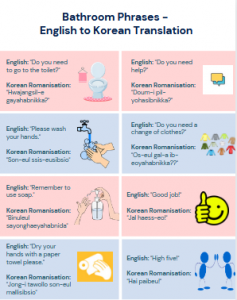19 English to Korean phrases
Amy Gale

Download the resource: Gale Intercultural Resource
The purpose of this resource is to assist educators of Korean speaking children with toilet and bathroom practices. In 2016, the Australian census recorded that over 100,000 people in the country spoke Korean as their first language, meaning that it is more than likely educators will encounter children in the centre environment who predominantly speak Korean at home (Australian Bureau of Statistics, 2016). For this reason, it is essential that educators have a way to communicate with the young children they are caring for, especially when considering caring practices such as toilet training (NSW Government, 2011). This resource could be placed on the wall of the bathroom area so that an educator has easy access to Korean translations of common English phrases which can be used to ask the child if they need help, give instructions or offer praise.
Speaking to children in their first language, especially when they are upset or require praise, is beneficial as it makes them feel comforted (Busse et al., 2019). Furthermore, having their home language incorporated into their educative environment allows children to feel acknowledged and accepted, leading to the development of positive attitudes towards learning (Busse et al., 2019). Additionally, families feel more connected to their child’s learning when they feel that their cultural or linguistic identities are being acknowledged in their child’s classroom (Yates et al., 2012). When families have a positive attitude towards the early childhood education and care settings their children are enrolled in, this enhances children’s educational experiences and outcomes (DEEWR, 2009).
Links
Early Years Learning Framework (DEEWR, 2009)
- Outcome 5: Children are effective communicators
- 5.1 Children interact verbally and non-verbally with others for a range of purposes.
Queensland Kindergarten Learning Guideline (QCAA, 2018)
- Communicating: Exploring and expanding language
National Quality Standard (ACECQA, 2018)
- Quality Area 5: Relationships with children
- 5.1 Positive educator to child interactions: Responsive and meaningful interactions build trusting relationships which engage and support each child to feel secure, confident and included.
- 5.2 The dignity and rights of every child are maintained.
- Quality Area 6: Collaborative partnerships with families and communities
- 6.1 Parents views are respected: The expertise, culture, values and beliefs of families are respected and families share in decision-making about their child’s learning and wellbeing.

